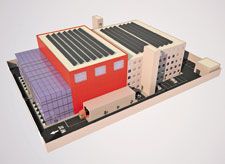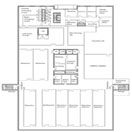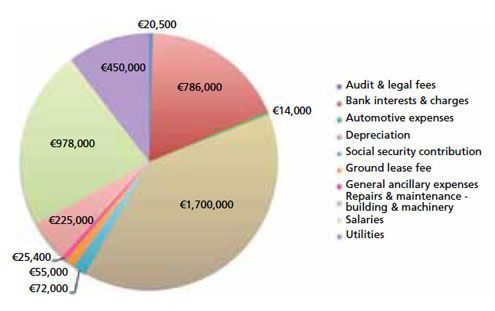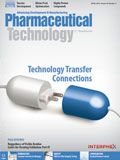Concept Design for Establishing an Eco-Friendly Pharmaceutical Production Facility in Malta
The authors discuss the concept design of a versatile, sustainable, small-scale facility in Malta that conforms to the European Union’s current good manufacturing practices.
IMAGE COURTESY OF THE AUTHORS

For companies involved in logistical and distribution activities, Malta offers several advantages, such as social and economic permanence, a robust legal framework, governmental financial incentives for various industries, easy access to policy decision makers, and a skillful, multilingual workforce with high productivity levels (1) (see Sidebar on SWOT analysis). Malta’s strategic geographical position, at the crossroads of the Mediterranean between Europe and Africa, makes the island an ideal gateway for value-added pharmaceutical services such as sorting, repackaging, and distribution for the Euro-Mediterranean, Middle East, and North Africa (MENA) regions. Medicinal products imported from Asian markets can have their marketing authorization granted in Malta, as it is recognized in other regulated European countries according to the mutual recognition procedure (2). Malta’s membership in the European Union puts it at the same level as other EU member states according to the Roche-Bolar provision and data exclusivity (3). The foundations for a sustainable pharmaceutical industry have been established by the Malta Medicines Authority, including an entrenched regulatory framework in line with the EU’s current good manufacturing practices (cGMP).
In this paper, the authors took an innovative approach to the design of a versatile, sustainable, small-scale facility in Malta that conforms to EU cGMP. The proposed facility will employ cutting-edge technology in energy, which further enhances the sustainability of the project while decreasing running costs.
Uses of a small-scale facility
Mini-scale pharmaceutical facilities are built to provide design data for larger production facilities or to act as hubs for batch-release activities and provide services that would otherwise be cost-ineffective for larger companies (4). Examples of activities that could be undertaken by such facilities include research and development, small-scale manufacturing and quality control studies, repackaging, micronization, and batch releases to European and African markets (5).
Methods
This research group undertook this study to assess the costs incurred by a multi-story, small-scale pharmaceutical facility. The first phase of the study involves designing a sustainable facility that incorporates environmental and structural aspects. The manufacturing unit is designed vertically to take advantage of height-to-volume ratio, thus reducing the ground footprint. Site visits to local oral solid-dosage (OSD) form facilities, together with extensive research in EudraLex Volume 4 guidelines on GMP and peer-reviewed literature, were instrumental in accumulating sufficient information to be able to design the facility, using AutoCAD 2014. Validation sessions with industry experts were conducted to assess the practicality of the proposed facility plan. The group of experts consisted of an architect, a qualified person with a pharmaceutical set-up background, a pharmaceutical logistician with experience in various pharmaceutical start-ups, a health and safety and security consultant, an engineer with experience in the pharmaceutical industry, a regulatory officer, and a pharmaceutical waste control specialist.
A fixed capital investment (FCI) plan has been drawn up, which forms part of the second phase of this research. FCI was identified using the “detailed-item estimate” method (6). A list of items required for the planned facility was established through site visits and as part of the design criteria. This exercise was then carried out by scrutinizing online product brochures and requesting quotations from corresponding local suppliers. Careful planning was given to the construction, main process equipment, and laboratory equipment, as well as utilities, such as heating ventilation air conditioning (HVAC), and systems for water purification, steam, vacuum, dust collection, and compressed air. The aforementioned considerations are the basic requirements for a start-up and require the most extensive capital investment. Quotations for building-integrated photovoltaic system, photovoltaic panels, and intelligent lighting were also sought.
The third phase consisted of estimating the number of full-time personnel required to run the facility. Average wage structure was gathered from a local pharmaceutical company. The annual operational costs were estimated, taking into account bank loan interests without security, depreciation expenses according to local legislation (7), and land rent from Malta Enterprise (i.e., the national governmental agency responsible for promoting and facilitating foreign investment and industrial development), electricity expenditure in line with local unit costs, and other expenses gained according to local expense rates.
Facility design
CLICK TO ENLARGE Figure 1: Ground floor plan.

The facility under consideration is a stand-alone, multi-story facility that could produce several non-sterile OSD products, except drugs of abuse and cytotoxic drugs. Its façade is planned to accommodate for the installation of integrated photovoltaic technology. The facility is planned to be south-facing to optimize natural lighting for the auxiliary area.
It is envisaged that the facility will make use of approximately 4700 m2 of land, with a floor area of approximately 8000 m2 spanning four separate levels with interacting industrial lifts. Waste and solvent rooms as well as an electricity substation were planned separately from the facility to minimize safety risks. An underground parking area can also be considered for the facility.
The ground floor (see Figure 1), with a height equivalent to two stories, will include the warehouse that includes a dispensing area containing a down-flow booth using extract technology. The notion behind having a dispensing area on the ground floor is to reduce the waste flowing into the first and second level.
CLICK TO ENLARGE Figure 2: First floor plan.

The first floor (see Figure 2) will be for the packaging of OSD, with locked storage for the printed packaging material. It will have direct access to the lift from the dispensing area. The plans accommodate for eight blister lines and/or bottling lines. It was taken into consideration that both primary and secondary packaging processes will be carried out in ISO Class 8 areas. This floor will also accommodate a microbiology and chemistry laboratory. Through the latter, one can access the stability chambers.
The second floor (see Figure 3), with height equivalent to two stories, will host the actual tableting process, including granulation, compression, and coating, which are maintained at ISO Class 8 specifications. A technical corridor runs around the perimeter of this level to enable technical support and maintenance of the equipment. The rationale behind having these processes on the uppermost level is that they will require extensive use of utilities and services. By putting them on the top level, savings are achieved in duct work installation, and air system complexity is minimized (8). Shafts for these processes can be constructed to provide to this level through the ceiling and allow the other shafts to supply the ground and first floors. There is also a research and development laboratory on this level, with an interacting samples room.
CLICK TO ENLARGE Figure 3: Pressure cascade system on second floor.

A utility and services space is on the uppermost area of this unit, which will include services for HVAC, vacuum, steam, water purification, dust collection, and compressed air. This space will be roofed over to protect the equipment and pipes from harsh weather.
Plans for the various floors take into consideration unidirectional flow of personnel, material, and waste to prevent cross-contamination (9). Standard operating procedures (SOPs) will form part of a quality system to regulate GMP activities within the facility.
Pressure cascade system
The pressure cascade system is managed by the HVAC system, which provides air as necessary to create pressure. Spaces that should remain cleaner than their adjacent areas must have a higher positive pressure (8). Processing rooms have lower pressure than the clean corridor, so that the higher pressure in the corridor helps in leaving contaminants in their respective suites and prevents their transfer through the corridor. The concept of the pressure cascade system for the second level of the facility is depicted in Figure 3.
Bubble airlocks were designed to act as transitions between the unclassified and classified zones. Bubble airlocks usually have higher pressures than the adjacent areas, to keep any contaminants in their area (10). Prior to entering any lift in the production area, airlocks (AL) were also designed so as to isolate any possible contamination coming from the warehouse, which is essentially an unclassified area.
Figure 4: Pie chart depicting the breakdown of fixed capital investment.

Fixed capital investment
The capital expenditure, worked in a detailed-cost estimation, amounted to nearly €13.4 million. Figure 4 shows a breakdown of the capital cost.
Consideration was given to items that enhance sustainability, such as a building integrated photovoltaic system for the façade and photovoltaic cells on the roof, which are feasible renewable energy sources for Malta’s subtropical-Mediterranean climate. Sensors and LEDs for the auxiliary area, a reliable building management system, and building insulation were also taken into account.
Operational costs
A GMP pharmaceutical facility should have an adequate number of well-trained and qualified human resources (11). There will be 36 full-time employees engaged in the facility; 15 of whom will be designated in production roles. The remaining staff will be employed in non-production positions, including four personnel in quality and seven working in laboratories. Their total salary cost (including national insurance according to Maltese legislation) is just over €1 million.
Operational costs of this facility to hypothetically produce 100 million OSD over the year 2015 were estimated to exceed €4 million. Included in this figure is the depreciation cost. Depreciation is the measure of the decreasing cost of property over time, which is seen as an expense (12). According to Maltese law, deductions for wear and tear should be calculated in a straight-line method over a minimum number of years (7).
Energy saving measures taken into account for this facility, are estimated to enhance the bottom line by more than €70,000. Figure 5 shows a detailed breakdown of the operational costs.
Figure 5: Pie chart illustrating breakdown of running costs.

Environmental benefits
In today’s world, priority is given to safeguarding the environment in response to global warming. Large industries are wary of their carbon footprint, not only because of concern for the environment, but also to uphold the reputation of the company among the general public. “Green” issues to be tackled to boost a company’s environmental credentials include waste management, recycling, energy reduction, and conservation (13). Malta aims to encourage good practices, such as making optimal use of natural resources in an environmentally friendly manner (i.e., least possible usage and maximum re-usage) (14). The proposed facility will minimize carbon footprint by embracing renewable (i.e., solar) energy, which will also help the enterprise financially by reducing operational costs (15).
Efficient and sensible use of land and sea are crucial factors in the macroeconomic and social development of Malta given the high population density, space requirements for industry, and the land-intensive needs of waste disposal and shipping (16). Bearing in mind that there are no imposed height restrictions in industrial parks, a vertical facility will safeguard the relatively limited land space.
Conclusion
Local stakeholders believe that a small-scale OSD facility can meet the needs of a potential niche sector for the pharmaceutical industry in Malta, apart from biotechnology that will hopefully flourish on the island. It is imperative to note that investing in efficient infrastructures will contribute to the local growth of the pharmaceutical industry, thus having a positive effect on the biotechnology industry.
References
1. EY, “The Economy: Today & Tomorrow Malta’s Attractiveness Survey 2013,” EY.com (Malta, 2013).
2. Government of Malta, “Medicines (Marketing Authorization) Regulations,” (Malta), Oct. 26, 2007.
3. Focus Reports, “Malta: A Healthy Location for the Pharmaceutical Industry,” pharmaboardroom.com (London, January 2011), http://pharmaboardroom.com/article/country-report-malta-a-healthy-location-for-the-pharmaceutical-industry/
4. J.A. Toner and J.H. Worstell, “To Build or To Contract: The Economics of Pilot Plant Decisions,” AIChE Annual Meeting Conference (Cincinnati, OH, 2005).
5. R. Zerafa and A. Serracino Inglott, “Proposal for Setting a mini-scale Solid Oral Dosage Form Production Facility,” Dissertation (Malta, Feb. 28, 2012).
6. M.S. Peters, K.D. Timmerhaus and R.E. West, “Cost Estimation,” in Plant Design and Economics for Chemical Engineers , pp. 150-215, (McGraw-Hill, Singapore, 5th ed., 2004).
7. Income Tax Act, L.N. 298: Deduction (Wear and Tear of Plant and Machinery) Rules, (Office of the Prime Minister, Malta), pp. B3188-B3190.
8. A. Bhatia, “HVAC Design for Pharmaceutical Facilities,” CED Engineering.
9. European Commission, EudraLex Volume 4, Chapter 3: Premises and Equipment (Brussels, Aug. 13, 2014).
10. WHO, “Supplementary guidelines on good manufacturing practices for heating, ventilation and air conditioning systems for non-sterile pharmaceutical dosage forms,” WHO Technical Report Series (2011), pp. 215-260.
11. European Commission, EudraLex Volume 4, Chapter 2: Personnel (Brussels, Aug. 16, 2013).
12. M.S. Peters, K.D. Timmerhaus and R.E. West, “Depreciation,” in Plant Design and Economics for Chemical Engineers, pp. 267-294 (McGraw-Hill, Singapore, 5th ed., 2004).
13. D. Buker and J. Kaushik, Pharm. Eng. 31(3) 8-16 (2011).
14. Government of Malta, “Sustainable Development Act,” (Malta July 10, 2012).
15. M. Neelis, E. Worrell, and E. Masanet, “Energy Efficiency Improvement and Cost Saving Opportunities for the Pharmaceutical Industry: An ENERGY STAR Guide for Energy and Plant Managers” (Ernest Orlando Lawrence Berkeley National Laboratory, June 2008).
16. National Commission for Sustainable Development, “A Sustainable development strategy for the Maltese Islands 2007-2016” (Malta, Dec. 20, 2006).
Article Detailsâ¨
Pharmaceutical Technology
Vol. 40, No.4
Page: 38-49
Citation
When referring to this article, please cite it as M. Mercieca et al., “Concept Design for Establishing an Eco-Friendly Pharmaceutical Production Facility in Malta," Pharmaceutical Technology 40 (4) 2016.

Pharmaceutical Tariffs Are Imminent: How Industry is Bracing for Impact
April 16th 2025On April 14, 2025, the Trump Administration launched a national security-driven investigation into pharmaceuticals, a move that will likely result in tariffs being placed on pharmaceutical drugs, ingredients, and other components that are imported from outside of the United States.